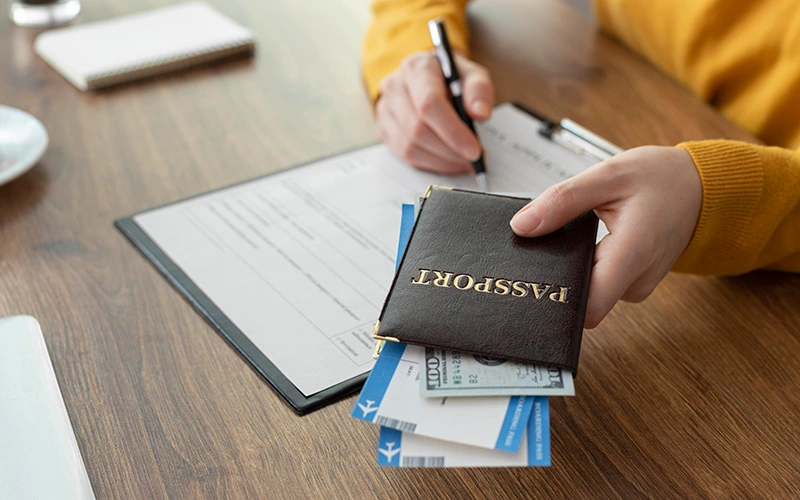A computerized system for immigration has been developed by UK Visas and Immigration. You will require an eVisa to verify your immigration status as of 2 June 2025. There will be no more acceptance of BRP or BRC cards. The UK eVisa system introduces a digital visa that is connected to your passport, making travel and immigration easier.
Travelers now have a more effective and secure way to handle their UK entrance needs thanks to this contemporary technology, which substitutes the outdated physical visa stickers. Residents of Dubai can take advantage of the new eVisa system when applying for a UK visa Dubai.
What is an eVisa?
Do you want to know what is an eVisa? It is a digital substitute for conventional visa stickers. An electronic record of your immigration status is called an eVisa. It will replace the current records that serve as evidence of your status, such as,
a) Biometric Residence Permits
b) Biometric Residence Cards
c) Endorsements in your passports, including entrance clearance stamps and stickers.
Who requires an eVisa?

You will need a UK evisa if you,
a) Have a UK visa issued for work, study, family, or long-term residency, you will require a UK e-visa.
b) If you have a 2 Years Multiple Entry UK Visa and have been authorized to remain in the country.
c) Have the right to stay indefinitely, but you presently need to provide proof of status in the form of a tangible document, such as a passport stamp or a BRP.
d) You are submitting an application to change or prolong your immigration status in the United Kingdom.
e) Have been given EU Settlement Scheme status.
If you are a British or Irish national and will be going to the UK for less than six months, or have indefinite leave to remain as shown by a stamp or vignette, you do not require an eVisa UK. However, it is advised that individuals who have tangible proof of indefinite status convert to an eVisa.
The Benefits of eVisas
The benefits of e-visa UK are,
a) Unlike paper documents, they are safe and cannot be misplaced, stolen, or altered.
b) Once your application is accepted, you will not have to wait for or pick up a physical document. However, you might still be required to supply biometric data in person.
c) You will be able to share your status with employers and landlords will be faster.
How to Obtain your eVisa
You must first create a UK Visas and Immigration account before your UK eVisa application. Accessing your eVisa and creating a UKVI account are free of charge.
1) Open an account on UKVI
Create an account with a working phone number and email address. You may view and share your UK Visa Status Online with this account, along with your rights to work, rent, and study in the country.
2) Verify your Identity
With a compatible smartphone and your passport or biometric residency permit, use the UK Immigration ID Check app to confirm your identification.
3) Connect your eVisa and account
Your UKVI account will be connected to your immigration status after your identification has been verified. An email will be sent to you once this is finished.
4) Keep your details up to date
Your UKVI account allows you to change personal information, including your contact information and current passport details. It is important that you keep your passport details up to date on this account.
5) Generate a Share Code
Share your immigration status with your landlord, employer, or other third party.
What does an eVisa look like?
An eVisa is a digital record kept in the UKVI system. It does not physically resemble a passport vignette or a BRP.
a) Your entire name will appear on your eVisa when you log into your UKVI account.
b) The type of immigration you have, such as student, skilled worker, or indefinite leave to remain.
c) The terms of your visit, such as your ability to work, study, or rent.
d) Your passport number, which needs to correspond with the one you currently have on file.
e) The duration of your status (beginning and ending dates, if time-limited).
f) Choices include creating a share code for landlords or employers or Update information like your contact details or passport.
How to link your passport to your eVisa
For your immigration status to be accurately confirmed when you travel or to demonstrate your eligibility to work or rent in the UK, your eVisa needs to be connected to your recent and valid passport. If your eVisa is not linked to your current passport, you may be denied boarding or detained at the crossing. Airlines and border officials use your passport number to verify your status. If your information does not match, employers and landlords may also have trouble confirming your status.
1) Visit the official government website to link your passport to your eVisa.
2) Enter your email address and password to access your UKVI account.
3) Click Update your information, then pick whether to update your identity document or passport.
4) Type in the country of issue, your new passport number, and the dates of issue and expiration.
5) Submit the changes. You will receive confirmation, and UKVI may contact you if further verification is needed.
eVisas for Children

Everybody needs to have an exclusive UKVI account. To enter the UK, minors and children need a separate eVisa. No matter their age, all minors must travel with their own UK e-visa. Each child must have a separate application submitted by their parents or legal guardians, along with a valid passport and identity. To confirm the identity of the minor, supporting documentation is frequently needed, such as evidence of relationship and travel information. A parent or guardian should create and administer an account for a child under the age of eighteen if they are unable to do it themselves.
Common Issues with eVisas
1) Due to airline incapacity to validate eVisas, many travelers have complained of being refused to board or experiencing delays at international airports, especially in the early phases of the implementation process. Practical issues still exist even though the Home Office promised that carriers may access immigration status through automated checks or the View and Prove service. Some passengers experienced anxiety and missed their flights as a result of having to use their own devices to access their UKVI accounts in order to prove their status.
2) Those without access to or knowledge of digital technology, such as refugees, and asylum seekers have been particularly affected. Some people have had trouble accessing their eVisas, which has made it more difficult for them to get housing, work, or assistance. Refugees were sometimes given eVisa accounts that were connected to Home Office email addresses, which prevented them from accessing their own immigration status data.
3) A number of technical issues have also been reported by users, such as the inability to link new passports to their eVisa accounts. Errors in the personal information are displayed on the eVisa. There is trouble creating or using share codes for housing or employment purposes.
4) Employers, landlords, and healthcare providers are among the service providers who have also demonstrated a lack of familiarity with the eVisa system. As a result, visa holders have had trouble verifying their status, which has led to service denials or demands for extra paperwork.
5) Due to several problems, the original deadline for switching to eVisas, was originally scheduled for 1 January 1, 2025. It was moved to 1 April 2025, and then again to 1 June 2025. Confusion has arisen between service providers and visa holders as a result of inconsistent information regarding the changes, especially with these extensions.
Concluding Remarks
I hope your question about what is eVisa has been answered. If you are experiencing problems with your eVisa, use the official government service to report errors. For help with technical issues or account access concerns, you can also get in touch with the UKVI Resolution Centre. Seek expert assistance if you are incapable of handling problems on your own.
Note that the government will still accept earlier documents, like a stamp or sticker in your passport, as confirmation of immigration status. If you have an expired biometric residence permit (BRP), you can use it for up to 18 months after its expiry. However, you should think about applying for an eVisa as soon as possible.
